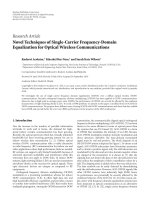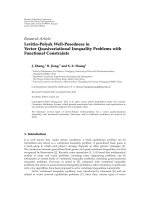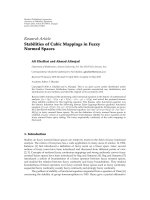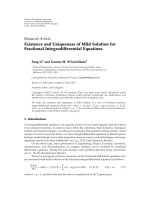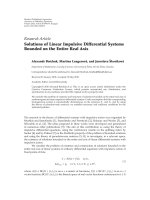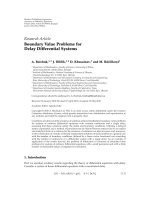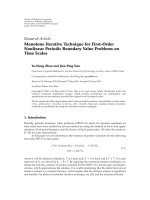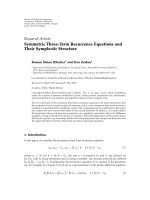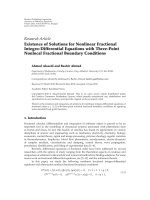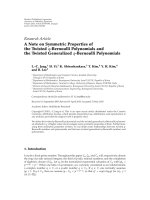Báo cáo sinh học: " Research Article Inverse Modeling of Respiratory System during Noninvasive Ventilation by Maximum Likelihood Estimation" doc
Bạn đang xem bản rút gọn của tài liệu. Xem và tải ngay bản đầy đủ của tài liệu tại đây (1.04 MB, 12 trang )
Hindawi Publishing Corporation
EURASIP Journal on Advances in Signal Processing
Volume 2010, Article ID 237562, 12 pages
doi:10.1155/2010/237562
Research Article
Inverse Mo deling of Respiratory System during
Noninvasive Ventilation by Maximum Likelihood Estimation
Esra Saatci (EURASIP Member)
1
and Aydin Akan (EURASIP Member)
2
1
Department of Electronic Engineer ing, Istanbul Kultur University, Bakirkoy, 34156 Istanbul, Turkey
2
Department of Electrical and Electronics Engineer ing, Istanbul University, Avcilar, 34320 Istanbul, Turkey
Correspondence should be addressed to Esra Saatci,
Received 2 October 2009; Revised 25 February 2010; Accepted 31 May 2010
Academic Editor: Satya Dharanipragada
Copyright © 2010 E. Saatci and A. Akan. This is an open access article distributed under the Creative Commons Attribution
License, which permits unrestricted use, distribution, and reproduction in any medium, provided the original work is properly
cited.
We propose a procedure to estimate the model parameters of presented nonlinear Resistance-Capacitance (RC) and the widely
used linear Resistance-Inductance-Capacitance (RIC) models of the respiratory system by Maximum Likelihood Estimator (MLE).
The measurement noise is assumed to be Generalized Gaussian Distributed (GGD), and the variance and the shape factor of the
measurement noise are estimated by MLE and Kurtosis method, respectively. The performance of the MLE algorithm is also
demonstrated by the Cramer-Rao Lower Bound (CRLB) with artificially produced respiratory signals. Airway flow, mask pressure,
and lung volume are measured from patients with Chronic Obstructive Pulmonary Disease (COPD) under the noninvasive
ventilation and from healthy subjects. Simulations show that respiratory signals from healthy subjects are better represented
by the RIC model compared to the nonlinear RC model. On the other hand, the Patient group respiratory signals are fitted to
the nonlinear RC model with lower measurement noise variance, better converged measurement noise shape factor, and model
parameter tracks. Also, it is observed that for the Patient group the shape factor of the measurement noise converges to values
between 1 and 2 whereas for the Control group shape factor values are estimated in the super-Gaussian area.
1. Introduction
The assessment of the respiratory function is an important
part of the clinical medicine [1]. Although the clinicians
use some standard evaluation techniques and there are
bewildering variety of computerized test equipments, the
automatic measurement of the lung mechanics requires
further work. The main existing problems presented are the
following. (i) The lung is a dynamic system such that its
parameters should be monitored continuously even with the
ventilatory assistance [2]; (ii) the signals measured at the
output of this dynamic system, the input, and the system
parameters might b e nonlinearly related to each other over
one breathing period [2, 3]; and (iii) the proposed methods
for investigating the lung mechanics should not require any
kind of patient’s cooperation.
Using the measured respiratory signals (i.e., airway flow,
˙
V(t), and airway pressure (mask pressure), P
aw
(t)), in
the literature, conventional least square (LS) and recursive
least square methods were used to estimate the linear and
nonlinear model parameters of the respiratory system [4–
7]. Regarding the measured time series of airway flow and
mask pressure, the abovementioned studies have two major
assumptions: (i) the airway flow and the mask pressure are
deterministic signals, and (ii) the uncertainty (referred to
as a measurement noise) between the measurements and
the model is zero-mean Gaussian distributed white noise.
However, to the best of our knowledge, there is no study
which attempts to define the noise in the respiratory system
model fitting to the measured respiratory signals. Thus it
is of interest to choose generalized noise model to express
the measurement noise involved in the respiratory system
identification problem.
In this study, we present the well-known Maximum
Likelihood Estimation (MLE) for the respiratory parameter
estimation, by assuming that the measurement noise is Gen-
eral Gaussian Distributed (GGD). MLE together with GGD
constitute a statistically powerful method which allows more
2 EURASIP Journal on Advances in Signal Processing
degrees of freedom to explore the statistical parameters of the
measurement noise. In the simulations, recently presented
nonlinear Resistance-Capacitance (RC) and widely used
linear Resistance-Inductance-Capacitance (RIC) models [5,
8] were used to represent the respiratory system. Accordingly,
one of our aims was to derive the theoretical expressions of
the presented lung models in the framework of the MLE
algorithm with the GGD noise model. In this respect, the
artificially produced airway flow and the mask pressure
signals that mimic the patients with Chronic Obstructive
Pulmonary Disease (COPD) under non-invasive mechanical
ventilation were used for the estimator assessment. Then, the
parameters of both respiratory models were e stimated from
the observed signals collected from the COPD patients under
non-invasive mechanical ventilation (Patient g roup) and the
healthy subjects (Control group).
The rest of the paper is organized as follows. Section 2
reviews the nonlinear RC and RIC models of the respiratory
system during non-invasive ventilation. The measurement
equations of the models are also drawn in Section 2.In
Section 3, MLE and GGD are summarized and the estima-
tion of the RIC and nonlinear RC models’ parameters is
explained. Also estimator performance assessment criteria
(i.e., the Cramer-RAO Lower Bound (CRLB)) were depicted
in the same section. In Section 4 , the experimental procedure
was explained. The results of the simulations are presented
and discussed in Section 5. Finally, in Section 6 conclusions
are drawn.
2. Respiratory Models
In this paper we used the nonlinear RC [8]andRIC
models [5] of the respiratory system. The nonlinear RC
model is the simplified version of the lung model in [3]
where its parameters are also verified. Since, time-domain
methods require well description of the respiratory system,
the non-invasive ventilation and muscular pressure effects
should be included to both models for the complete system
representation. P
mus
(t) represents the pressure effects on
the measured P
aw
(t) produced by the patient’s inspiratory
muscles. The ventilator-generated pressure P
ven
(t)hasa
direct effect on P
aw
(t) as it is the major positive component
shaping the waveform. To express the reality, P
ven
(t)is
only used in models of the Patient Group. It should be
emphasized that pressure sources P
mus
(t)andP
ven
(t)reflect
only the related effects on the P
aw
(t); thus they should not
be considered as direct lung model functions. P
mus
(t)canbe
approximated by the second-order polynomial function [9]:
P
mus
(
t
)
=
⎧
⎪
⎨
⎪
⎩
−
P
mus max
1 −
t
T
I
2
+ P
mus max
,0≤ t ≤ T
I
,
P
mus max
e
−t/τ
m
, T
I
≤ t ≤ T,
(1)
where P
mus max
represents the effect of the maximal patient’s
effort on P
aw
(t), T
I
and T are the inspiration duration and
the total duration of one respiration cycle, respectively. In
this paper P
mus max
is added to the unknown parameter
vector whereas T
I
and T are set to constant values derived
P
mus
(t)
P
ven
(t)
P
aw
(t)
−
+
−
+
R
−
+
C
(a)
P
mus
(t)
P
ven
(t)
P
aw
(t)
−
+
−
+
C
LR
−
+
(b)
Figure 1: (a) Nonlinear one-compartment respiration model with
noninvasive ventilator effect. (b) Linear one-compartment RIC
model of the lung with noninvasive ventilator effect.
from the experimental signals. The time constant τ
m
is an
important parameter for mostly determining the expiratory
asynchrony in the noninvasive ventilation [9]. A constant
value was chosen for τ
m
in order to resemble the respiratory
system.
The ventilator-generated pressure P
ven
is modeled by the
exponential function [9]:
P
ven
(
t
)
=
⎧
⎪
⎪
⎪
⎪
⎨
⎪
⎪
⎪
⎪
⎩
PEEP, 0 ≤ t ≤ t
trig
,
P
ps
1 − e
−t/τ
vi
, t
trig
<t≤ T
I
,
P
ps
e
−t/τ
ve
, T
I
<t≤ T,
(2)
where P
ps
and PEEP represent the maximal ventilation
pressure and Positive End Expiration Pressure, respectively.
The ventilator inspiration time constant τ
vi
corresponds
to the flow acceleration speed of the ventilator, whereas
the ventilator expiration time constant τ
ve
is the ventilator
deceleration speed and contributes to the pressure rise at
the termination of the inspiration. The set values for the
parameters in P
mus
(t)andP
ven
(t)areinTable 1 . P
mus
(t)and
P
ven
(t) were applied in the simulations of the artificial signals
and COPD patients’ signals, whereas, for the control group,
P
ven
(t) was not included to respiratory models.
Figure 1 shows the nonlinear RC and R IC models of the
respiratory system. In continuous time, the model output
EURASIP Journal on Advances in Signal Processing 3
equations, respectively, are
P
aw
(
t
)
=
A
u
+ K
u
˙
V
(
t
)
˙
V
(
t
)
+ A
l
e
K
l
V(t)
+ B
l
− P
mus
(
t
)
+ P
ven
(
t
)
,
P
aw
(
t
)
= V
(
t
)
E +
˙
V
(
t
)
R +
¨
V
(
t
)
L
− P
mus
(
t
)
+ P
ven
(
t
)
,
(3)
where A
u
, K
u
, A
l
, K
l
, B
l
,andR, E, L constitute the unknown
parameter vectors for the nonlinear RC and RIC models,
respectively. P
aw
(t) is the measured mask pressure and
˙
V(t)
is the measured airway flow. V(t) represents the gas volume
changes above the Residual Volume (RV) in the lungs and
¨
V(t) is the gradient of the airway flow.
In discrete form, the obser ved time series of mask
pressure for the nonlinear RC and RIC models of the
respiratory system are given by
P
aw
k
=
⎧
⎪
⎪
⎪
⎪
⎪
⎪
⎪
⎪
⎪
⎪
⎨
⎪
⎪
⎪
⎪
⎪
⎪
⎪
⎪
⎪
⎪
⎩
A
u
+ K
u
˙
V
k
˙
V
k
+ A
l
e
K
l
V
k
+ B
l
−P
mus max
1−
1−
k
N
I
2
+P
ven
k
+r
k
,0≤k ≤ N
I
,
A
u
+ K
u
˙
V
k
˙
V
k
+ A
l
e
K
l
V
k
+ B
l
−P
mus max
e
−(kΔt
s
)/τ
m
+ P
ven
k
+ r
k
, N
I
≤k ≤ N,
(4)
P
aw
k
=
⎧
⎪
⎪
⎪
⎪
⎪
⎪
⎪
⎪
⎪
⎪
⎪
⎪
⎪
⎪
⎪
⎪
⎪
⎪
⎪
⎪
⎪
⎪
⎪
⎪
⎪
⎪
⎪
⎪
⎪
⎪
⎪
⎪
⎪
⎪
⎪
⎨
⎪
⎪
⎪
⎪
⎪
⎪
⎪
⎪
⎪
⎪
⎪
⎪
⎪
⎪
⎪
⎪
⎪
⎪
⎪
⎪
⎪
⎪
⎪
⎪
⎪
⎪
⎪
⎪
⎪
⎪
⎪
⎪
⎪
⎪
⎪
⎩
˙
V
k
V
k
˙
V
k+1
−
˙
V
k
Δt
s
−1+
1−
k
N
I
2
×
⎡
⎢
⎢
⎢
⎢
⎢
⎢
⎢
⎣
R
E
L
P
mus max
⎤
⎥
⎥
⎥
⎥
⎥
⎥
⎥
⎦
+P
ven
k
+r
k
,0≤k<N
I
,
˙
V
k
V
k
˙
V
k+1
−
˙
V
k
Δt
s
−e
−(kΔt
s
)/τ
m
×
⎡
⎢
⎢
⎢
⎢
⎢
⎢
⎢
⎣
R
E
L
P
mus max
⎤
⎥
⎥
⎥
⎥
⎥
⎥
⎥
⎦
+P
ven
k
+r
k
, N
I
≤k ≤ N,
(5)
where r
k
is the GGD measurement noise; N and N
I
are
the discrete versions of T and T
I
; discrete time steps are
Δt
s
= 1/f
s
= 10
−2
s,andΘ =
[
A
u
K
u
A
l
K
l
B
l
P
mus max
]
T
and Θ = [RLEP
mus max
]
T
are the parameter vectors to be
estimated.
Deriving (4)and(5) constitutes the first step for the
respiratory parameter estimation by MLE.
3. Estimation of the Model Parameters by MLE
If the nonlinear time series model y
k
= h
k
(x
k
, Θ, u
k
, r
k
)is
considered, then MLE algorithm can be applied to estimate
the unknown parameters, Θ,wherex
k
are the model states,
u
k
are known inputs, and r
k
represents the measurement
noise. Since the states are measured signals in our models,
we omit x
k
terms in the MLE derivations. In MLE, the
parameters are assumed to be the unknown but deterministic
constants and the measurements are used to calculate
the likelihood as a function of the parameters. Then the
parameters are calculated by
δ log
L
Θ | y
1:N
δΘ
m
= 0, m = 1, , p,(6)
where p is the total number of the parameters. In this study,
the Newton-Raphson (NR) method is used for the iterative
maximization of (6). At the (i + 1)th iteration, the parameter
vector is computed by
Θ
(i+1)
= Θ
(i)
− g
Θ
(i)
H
Θ
(i)
−1
,(7)
where the indices represented in the parentheses are the
iteration steps. g(
·) function denotes the gradient vector
of the logarithmic likelihood function, whereas H(
·) is the
Hessian matrix, composed of the second deviates of the
logarithmic likelihood function:
g
(
Θ
)
=
∂ log
L
y
1:k
; Θ
∂Θ
m
1,m
,
H
(
Θ
)
=
∂
2
log
L
y
1:k
; Θ
∂Θ
m
∂Θ
r
m,r
.
(8)
Iteration of (7) continues until the condition for the set
ε, L(
Θ
ML
|y
1:k
) − L(Θ|y
1:k
) ≥ ε or i = i
max
, is met. Then, the
final iteration provides the parameter vector, Θ.Moreover,
the estimator v ariance is calculated as
var
Θ
=
H
(
Θ
)
−1
. (9)
We now need to define the measurement noise and
propose the probability distribution for the best convergence
of the parameters.
3.1. Generalized Gaussian Distributed Noise Model. Mea-
surement noise has two main components: (i) the noise-
like residuals resulted from the model fitting to the mea-
sured signals (biggest part); (ii) random noise resulted
from the measurement equipment and the valve system of
the noninvasive ventilator. Based on the assumption that
measurement noise, r
k
, is GGD type, the measurement
probability distribution can be given as
Pr
y
1:k
; Θ
=
c exp
⎧
⎨
⎩
−
1
A
p
r
, σ
r
p
r
N
k=1
y
k
− h
k
(
Θ
)
p
r
⎫
⎬
⎭
,
(10)
4 EURASIP Journal on Advances in Signal Processing
1234
15
25
20
30
20
30
40
50
60
R
Iteration
1234
Iteration
1234
Iteration
1234
Iteration
3
4
5
6
7
×10
−3
×10
−3
×10
−3
×10
−3
L
E
20
30
40
25
35
45
P
mus max
(a)
A
u
1234
Iteration
1234
Iteration
1234
Iteration
1234
Iteration
1234
Iteration
1234
Iteration
0
20
40
K
u
100
150
200
100
150
200
A
l
B
l
0
K
l
P
musmax
0.005
0.01
0.015
0.01
0.02
0.03
500
1000
(b)
Figure 2: Cramer-Rao Lower Bounds (dotted red line) and estimator variances (black line) versus iteration.
0
1
2
0.5
1.5
MSE for R
30 40 50 60
0
1
0.5
1.5
30 40 50 60
SNR (dB)
SNR (dB)
30 40 50 60
0
1
0.5
1.5
SNR (dB)
30 40 50 60
SNR (dB)
0
0.2
0.4
0.6
0.8
MSE for L
MSE for P
musmax
MSE for E (1/C)
(a)
0
MSE for K
l
MSE for A
l
200
100
0
200
100
30 40 50 60
SNR (dB)
30 40 50 60
SNR (dB)
0
0.2
0.4
MSE for A
u
30 40 50 60
SNR (dB)
30 40 50 60
SNR (dB)
0
5
10
MSE for K
u
MSE for P
musmax
MSE for B
l
200
100
0
30 40 50 60
SNR (dB)
30 40 50 60
SNR (dB)
0
0.2
0.4
(b)
Figure 3: (a) Mean Squared Error (MSE) versus SNR for linear RIC model parameter estimation produced by artificial signals. (b) Mean
Squared Error (MSE) versus SNR for nonlinear model parameter estimation produced by artificial signals.
EURASIP Journal on Advances in Signal Processing 5
where h
k
(Θ) is the many-to-one function that yields
the left side of (4)or(5). c can be defined as c
=
1/(2
N
Γ(1 + 1/p
r
)
N
A(p
r
, σ
r
)
N
), where Γ(·) is the Gamma
function and A(p
r
, σ
r
) = [σ
2
r
Γ(1/p
r
)/Γ(3/p
r
)]
1/2
is a scaling
factorwhichallowsthatvar(r
k
) = σ
2
r
. The variance and
the shape factor of GGD are represented as σ
2
r
and p
r
,
respectively. These two parameters should be estimated in
order to define the measurement noise. It is reminded
that since the respiratory system, consequently respiratory
signals, differs between diseased and healthy cases, we expect
the parameters of GGD-based measurement noise to provide
the valuable information about the respiratory models fit to
the measured signals.
3.1.1. Measurement Noise Variance Estimation. A common
way of estimating the measurement noise variance consists of
maximizing the logarithmic likelihood func tion with respect
to σ
2
r
:
∂ log
L
y
1:N
; Θ, σ
r
, p
r
∂σ
r
= 0. (11)
With the help of the conditional probability theorem, by
(10), the logarithmic likelihood func tion and the variance in
the closed form can be obtained, respectively, as
L
y
1:k
; θ
=−
N
log 2 + log Γ
1+
1
p
r
+logA
p
r
, σ
r
−
1
A
p
r
, σ
r
p
r
N
k=1
y
k
− h
k
(
Θ
)
p
r
,
(12)
σ
r
=
⎡
⎣
p
r(i)
N
Γ
1/p
r(i)
Γ
3/p
r(i)
−p
r(i)
/2
N
k=1
y
k
−h
k
Θ
(i)
p
r(i)
⎤
⎦
1/p
r(i)
.
(13)
It should also be noted that, in the above derivation, the
system model parameters, Θ, and the measurement noise
shape factor, p
r
, are considered as known quantities.
3.1.2. Measurement Noise Shape Factor Estimation. In the
GGD models the shape factor, p
r
,canbeestimatedwith
four different methods [10]. In this study, the Kurtosis ratio
method was chosen due to its simplicity and its success for
the small values of p
r
. The Kurtosis ratio is computed by
ξ
p
r
=
E
|
r
k
|
2
E
|
r
k
|
4
=
Γ
3/
p
r
Γ
5/
p
r
Γ
1/
p
r
, (14)
where E[
|r
k
|
4
]andE[|r
k
|
2
] denote the fourth- and second-
order central moments of the measurement noise, respec-
tively. However, (14) cannot be solved in the explicit form.
Thus, a lookup table was generated for the inversion of the
Kurtosis equation.
3.2. Estimation of the Model Parameters. Once the variance
and the shape factor of the measurement noise are estimated,
parameters of the respiratory models can be computed with
the MLE algorithm. Maximization of (12)withrespectofΘ
is computed with the Newton-Raphson (NR) algorithm. If
∇
Θ
shows the gradient vector, then the mth element is found
as
∇
θ
m
L
(
Θ
)
=
1
A
p
r
, σ
r
p
r
N
k=1
p
r
y
k
− h
k
(
Θ
)
p
r
−1
∂h
k
(
Θ
)
∂Θ
m
,
(15)
and from (12) the Hessian matrix can be achieved by
∇
θ
m
∇
θ
r
L
(
Θ
)
=
p
r
A
p
r
, σ
r
N
k=1
−
p
r
−1
y
k
−h
k
(
Θ
)
p
r
−2
∂h
k
(
Θ
)
∂θ
m
∂h
k
(
Θ
)
∂θ
r
+
y
k
− h
k
(
Θ
)
p
r
−1
∂
2
h
k
(
Θ
)
∂θ
m
∂θ
r
,
(16)
where |y
k
− h
k
(Θ)| is the error and the second term in
the sum can be ignored with respect to the first term; thus
(m, r)th element of the Hessian matrix becomes
∇
θ
m
∇
θ
r
L
(
Θ
)
=
−
p
r
p
r
− 1
A
p
r
, σ
r
N
k=1
y
k
− h
k
(
Θ
)
p
r
−2
∂h
k
(
Θ
)
∂θ
m
∂h
k
(
Θ
)
∂θ
r
.
(17)
Equations (15), (17), and (7) form the basis of the
MLE algorithm. It should also be noted that in the above
derivation the measurement noise shape factor, p
r
,and
variance, σ
2
r
, are considered as known quantities.
3.3. Estimator Performance Measurement. The MLE algo-
rithm, shown in Algorithm 1, was coded in Matlab and
applied first to the artificially generated respiratory signals
(mask pressure, airway flow, and lung volume), then to
respiratory signals acquired from the COPD patients with
the noninvasive ventilator assistance, and finally to the
healthy subjects. Before depicting the results from the real
respiratory signals, the performance of the estimator which
is bounded by the respiratory models and the properties of
the respiratory signals should be demonstrated. In statistical
signal processing there are two ways to measure the esti-
mator’s ability: (i) computing the Lower Bounds (LBs) on
the estimator’s variance and (ii) calculating the Mean Square
Error (MSE) on the estimated parameters. Both LB and MSE
are calculated with the true value of the parameters, thus with
the artificial signals. In the case of real signals, we estimated
the parameters from five different breath cycles of the same
subject and plotted on the same figure. Apart from the effects
of the small differences between breath cycles, the estimator
is expected to result in the same parameter estimations. This
procedure acts as a self-performance measurement in the real
signal processing.
6 EURASIP Journal on Advances in Signal Processing
246810
0
1
2
3
Iteration
Estimated var
r
(RIC model)
(a)
246810
0
1
2
3
Estimated var
r
(RC model)
Iteration
(b)
Figure 4: Estimated measurement noise variance produced by representative COPD patient (a) for RIC model and (b) for nonlinear RC
model.
12345678910
0.2
0.4
0.6
0.8
Iteration
Estimated var
r
(RIC model)
(a)
12345678910
0.2
0.4
0.6
0.8
Estimated var
r
(RC model)
Iteration
(b)
Figure 5: Estimated measurement noise variance produced by representative healthy patient (a) for RIC model and (b) for nonlinear RC
model.
3.3.1. Artificial Respiratory Signal. The airway flow inside the
upper airways was simulated as a sinusoidal signal with the
parameters shown in Table 1. The lung volume (i.e., Tidal
Volume) was calculated by the integration of the airway flow
over one breathing cycle. Pressure inside the facemask was
calculated by (14) for the nonlinear RC model and by (12)for
the RIC model with the help of the model parameters shown
in Table 1. Zero-mean white Gaussian noise with different
SNR levels was then added to the airway pressure and airway
flow.
3.3.2. Initial Values. Since Maximum Likelihood incor-
porates the “maximization” step and uses hill-climbing
approach, reaching only to local minima can be guaranteed.
However, there are two ways to avoid local minima: (1) to
change the initial values for different starting points and (2)
to find the optimum initial values by considering a nonlinear
respiratory model and the constraints on the parameters. In
our studies we employed the two approaches. Monte Carlo
averaging (MC
= 100) is used to decrease the effects of
the initial value selection whereas initial values are generated
from the constrained sets of the parameters. For the real
data case, same initial values were used for five different
breath cycle simulations. The mean and variance of the initial
values were chosen solely to achieve the convergence of the
parameters. On the other hand, the initial values of σ
2
r
and
p
r
were set to constant values. Table 2 summarizes the initial
values selected for the simulations.
3.3.3. Cramer-Rao Lower Bounds. Cramer-Rao Lower Bound
(CRLB) [11]isdefinedas
CRB
(
Θ
)
= I
(
Θ
)
−1
, (18)
where I(Θ)
=−E{(∂
2
L(y
1:k
; Θ))/(∂Θ
m
∂Θ
r
)} is called as the
Fisher Information matrix. If p
r
= 2andp
r
= 1 (i.e., the
measurement noise is considered as Gaussian and Laplacian
distributed), then the expected value of (16)withrespectto
the parameters vector yields, respectively, that
I
p
r
=2
(
Θ
)
=
2
A
(
2, σ
r
)
2
N
k=1
∂h
k
(
Θ
)
∂Θ
m
∂h
k
(
Θ
)
∂Θ
r
,
(19)
I
p
r
=1
(
Θ
)
=−
1
A
(
2, σ
r
)
2
N
k=1
∂
2
h
k
(
Θ
)
∂θ
m
∂θ
r
.
(20)
Pham and DeFigueiredo [12] showed that ML estimate
of the mean of GGD noise is unbiased for 1
≤ p
r
< ∞.
Moreover, the asymptotic behavior of ML estimates for the
uniform and Laplacian noises has been investigated in [13]
yielding that, even if the priori distribution of a noise is
unknown, the stochastic CRB can be attained asymptotically
by the ML estimator derived for a Gaussian signal. Hence,
EURASIP Journal on Advances in Signal Processing 7
246810
0
2
4
6
8
Iteration
Estimated p
r
(RIC model)
(a)
246810
0
2
4
6
8
Estimated p
r
(RC model)
Iteration
(b)
Figure 6: Estimated measurement noise shape factor produced by representative COPD patient (a) for RIC model and (b) for nonlinear RC
model.
Initialization
the parameter vector Θ
(i=0)
the variance of r
k
, σ
2
r(i
=0)
the shape factor of r
k
, p
r(i=0)
for i = 1, i
max
(i
max
is the maximum number of iteration)
Estimate σ
2
r
by (13)
Estimate p
r(i)
by (14) and lookup table
Calculate the gradient vector of the logarithmic likelihood function by (15)
Calculate the Hessian matr ix by (17)
Calculate Θ
(i+1)
by (7)
Continue until Θ is converged
Algorithm 1: MLE Algorithm.
Table 1: Parameters of the respiratory signals in the simulations. ER and EMP stand for experimental reading and estimated model
parameter, respectively.
Model Parameter Value
Artificial Sig. Patient G. Control G.
Noninvasive ventilator PEEP 4 cm H
2
OERN/A
Pressure simulation P
ps
6cmH
2
OERN/A
τ
vi
0.006 s 0.006 s N/A
τ
ve
0.006 s 0.006 s N/A
k
trig
(t
trig
) N/10 (T/10) ER N/A
N
I
(T
I
) N/3(T/3) ER ER
N (T) 300 (3 s)ERER
f
s
100 Hz 100 Hz 100 Hz
Muscular P
mus max
1cmH
2
OEMPEMP
Pressure simulation τ
m
60 ms 60 ms 60 ms
Nonlinear respiration A
u
3.1 cm H
2
O · s/l EMP EMP
Model parameters K
u
0.32 cm H
2
O · s
2
/l
2
EMP EMP
Θ A
l
0.1 cm H
2
OEMPEMP
K
l
1.0 EMP EMP
B
l
0cmH
2
OEMPEMP
P
mus max
1cmH
2
OEMPEMP
Linear RIC R 2.75 cm H
2
O · s/l EMP EMP
Model parameters L 0.0063 cm H
2
O · s
2
/l EMP EMP
Θ E
= 1/C 85.8 cm H
2
O/l EMP EMP
8 EURASIP Journal on Advances in Signal Processing
Table 2: Initial values selected for the simulations. N stands for the Gaussian distribution.
Parameter Value
Artificial Sig. Patient G. Control G.
RIC model
Parameter vector Θ
(i=0)
N (1/2, 1/4) N (1/2, 1/4) N (1/2, 1/4)
Varian ce of r
k
, σ
2
r(i
=0)
0.110.1
Shape factor of r
k
, p
r(i=0)
222
Nonlinear RC model
Parameter vector Θ
(i=0)
N (1/2, 1/4) N (5, 25) N (1, 1)
Varian ce of r
k
, σ
2
r(i
=0)
0.110.1
Shape factor of r
k
, p
r(i=0)
222
for the GGD-type measurement noise having shape factors
other than p
r
= 1, 2, we use asymptotic property of MLE
and accept (19) for the bound calculation.
Figure 2 shows the CRLB for the parameter estimates
together with the estimator variances in one breath cycle.
First of all, although we have convergence of the parameters
at i
= 2, we set i
max
= 4 for the demonstration of the
lower bound clearly. CRLB and parameter error variances
are calculated by (19)and(9), respectively, by processing
the artificial signals. As it is seen from Figure 2, the variance
of the estimator follows the CRLB very closely for all
parameters. Especially in RIC model MLE is very successful,
because estimator variances reach to the CRLB value at i
= 2
for all parameters. However, for the nonlinear RC model
it can be seen that A
l
, K
l
,andB
l
have very large CRLB
values, whereas A
u
and P
mus max
have lower CRLB values than
they have in RIC model. Interestingly, we also observe that
estimator variances follow the CRLB for the nonlinear RC
model parameters.
We can claim with some confidence that presented CRLB
values are the minimum attainable estimator variance bound
for the nonlinear RC model. First, CRLB is computed by the
real values of the model parameters (no initialization prob-
lem), and second, for the GGD-type measurement noise,
asymptotic efficiency and lack of bias of the ML estimates
can be used (Gaussian noise case). However, we note that,
because the Hessian matrix depends on the nonlinear model
parameters as wel l as GGD noise parameters, maximization
of the Fisher Information Matrix constitutes high variance
bounds. Thus we do not claim that the ML estimators are
the best choice among the estimator family. On the other
hand, both MSE and CRLB curves clearly suggest that, for
the nonlinear RC model, ML estimator gives the optimum
variance with regard to the CRLB.
3.3.4. Mean Square Error. The second way to show the
estimator performance is to demonstrate the error between
the set and the estimated parameters. Mean Square Error
(MSE) is calculated by Monte Carlo simulations with MC
=
100 as
mse
Θ
=
1
MC
MC
i=1
Θ −
Θ
(i)
2
(21)
and is plotted versus signal-to-noise ratio (SNR). The only
reason to use different SNR is to demonstrate the estimator’s
ability in estimating the parameters’ embedded different
noise variances. Since the measurement noise consists of
the residuals between the real measured signal and the
used respiratory model, we expect to estimate various
measurement noise variances.
Figure 3 shows the MSE versus SNR plots where Gaussian
distributed measurement noise is added. Figure 3 is very
inline with Figure 2 in a way that A
l
, K
l
,andB
l
param-
eters show higher MSE values than the rest. This can be
easily explained by the nonlinear dependance between these
parameters and the airway pressure. In other words, in the
nonlinear RC model, the Hessian matrix is calculated as
a function of these nonlinear parameters which in turn
increases the estimation errors at each iteration. However,
although MSE values were higher for nonlinear parameters,
the convergence was achieved for all parameters in the
nonlinear RC model. It is also interesting to notice that,
as it is in CRLB results, A
u
and P
mus max
have lower MSE
values than they have in RIC model. That is, although the
nonlinear RC model has nonlinear para meters that have
relatively higher MSE values, it is still optimum in the sense
of estimator performance.
4. Experiments
Seven male and one female patients with COPD and
four male and two female healthy nonsmoking subjec ts
(without any respiratory disease) were recruited. Patients
were breathing with the support of a non-invasive ventilator
(Respironics, Inc., BIPAP S/T IPAP: 10–12 cm H
2
O; PEEP:
4–6 cmH
2
O) via facemask (Respironics, Inc., spectrum size:
medium and small), whereas subjects from Control Group
were breathing via facemask without the support of the
non-invasive ventilation. In both Groups, the mask pres-
sure, the airway flow, and tidal volume were measured
by the pneumotachograph and the pressure transducer
system (Hans Rudolph, Inc., Research pneumotachograph
system). Acquired signals are digitized by a sampling rate
of 100 Hz. During acquisition, subjects were awake and in
supine position breathing through the facemask. At least 10
breathing cycles of the airway flow, the mask pressure, and
the lung volume signals were recorded by the data acquisition
EURASIP Journal on Advances in Signal Processing 9
12345678910
1
2
3
4
5
Iteration
Estimated p
r
(RIC model)
(a)
12345678910
1
2
3
4
5
Estimated p
r
(RC model)
Iteration
(b)
Figure 7: Estimated measurement noise shape factor produced by representative healthy patient (a) for RIC model (b) for nonlinear RC
model.
246810
0
1
2
0.5
1.5
Iteration
246810
Iteration
246810
Iteration
246810
Iteration
0
2
4
6
10
0
20
30
40
50
5
10
0
15
20
×10
−2
R (cm H
2
O·L
−1
·s)
L (cm H
2
O·L
−2
·s
2
)
E (cm H
2
O·L
−1
)
P
mus max
(cm H
2
O)
(a)
5101520
0
5
10
0
5
0
5
10
0
10
0
10
20
0
10
20
30
K
l
Iteration
5101520
Iteration
5101520
Iteration
5101520
Iteration
5101520
Iteration
5101520
Iteration
A
l
(cmH
2
O)
A
u
(cm H
2
O·L
−1
·s
−1
)
K
u
(cm H
2
O·L
−2
·s
−2
)
B
l
(cm H
2
O)
P
mus max
(cm H
2
O)
(b)
Figure 8: (a) Linear RIC model parameter estimation for five different breath cycles, produced by representative COPD patient’s signals. (b)
Nonlinear model parameter estimation for five different breath cycles, produced by representative COPD patient’s signals.
system (National Instrument DAQCard-6036E ADC-16bit)
and stored into the computer for signal processing.
The airway flow signal was the first software filtered to
remove high-frequency noise with 8th-order Butterworth
low-pass filter with cutoff frequency of 50 Hz, and then
processed to detect the breathing cycle onset and end.
Recorded signals were divided by breathing cycles with the
consideration of the ventilator trigger time, the inspiration,
and the expiration time. Five clear breathing cycles were
chosen for the processing step. Accordingly, the parameters
T, T
I
, t
trig
(i.e., N, N
I
,andk
trig
), PEEP, and P
ps
were set to the
real values measured from the subject’s respiratory signals. τ
vi
and τ
ve
were 0.006 s and τ
m
was set to 60 ms. MLE algorithm
depicted in Algorithm 1 was applied to the measured respi-
ratory signals, and the resulting measurement noise variance,
measurement noise shape factor, and parameter convergence
tracks were plotted. In order to assess the estimator, results
from five different breath cycles were illustrated on the same
figure.
5. Results and Discussion
5.1. Measurement Noise Variance and Shape Factor Estima-
tion. The variance and the shape factor of the measurement
10 EURASIP Journal on Advances in Signal Processing
246810
246810
246810
246810
0
0
0
0.1
0.2
0.3
0.4
0
0.1
0.2
0.3
0.4
Iteration Iteration
Iteration Iteration
5
10
2
4
6
8
×10
−2
×10
−2
R (cm H
2
O.l−1.s)
L (cm H
2
O.l−2.s
2
)
P
mus max
(cm H
2
O)
E (cm H
2
O.l−1)
(a)
246810
0
0.5
1
1.5
0
1
2
2
4
6
8
10
12
0
10
20
30
K
l
0
5
10
0
1
2
Iteration
246810
Iteration
246810
Iteration
246810
Iteration
246810
Iteration
246810
Iteration
A
u
(cm H
2
O · l
−
1 · s
−
1)
K
u
(cm H
2
O · l
−
2 · s
−
2)
A
l
(cm H
2
O)
B
l
(cm H
2
O)
P
mus max
(cm H
2
O)
(b)
Figure 9: (a) Linear RIC model parameter estimation for five different breath cycles, produced by representative healthy subject’s signals.
(b) Nonlinear model parameter estimation for five different breath cycles, produced by representative healthy subject’s signals.
noise were estimated for all subjects by MLE as depicted
in Algorithm 1. Figures 4 and 5 show the estimated σ
2
r
for
the representative subjects in the Patient group and in the
Control group, r espectively. Estimated p
r
is also shown in
Figures 6 and 7 for the representative subjects in the Patient
group and in the Control g roup, respectively. First of all, it is
apparent that both σ
2
r
and p
r
were converged to the specific
value for both groups and for all breath cycles.
From Figures 4 and 5, we can observe that measurement
noise variance is much higher in the Patient group than in
the Control group. As it is explained in the above section, the
initial σ
2
r
is set to 10 times hig h er in the Patient group due
to the convergence of the variance, and in the RIC model
it is increased to nearly 2. Also we can see that increase
in σ
2
r
is higher in the RIC model; thus, for the nonlinear
RC model, estimated measurement noise variance is lower
in the Patient g roup. Hence, first important finding can
be drawn that Patient group respiratory signals are fitted
to the nonlinear RC model with lower measurement noise
variance (i.e., lower the variance of the residuals) than to
the linear RIC model. Since the lower the variance the better
the distribution spotted (which means that the residuals are
concentrated to the mean with minimum variance), it is
easily concluded that the nonlinear RC model is better fitted
to the respiratory signals acquired from Patient group. On
the other hand, for the Control group it is totally reverse.
Respiratory signals from each healthy subject resulted in
higher σ
2
r
in the nonlinear RC model, so that the RIC model
is better fitted to the respiratory signals from Control group.
We can also support the above argument with the p
r
estimates. From Figure 6(b) we see that nearly all breaths
were con verged to p
r
∼ 1, but Figure 6(a) shows more
scattered convergence of the waveforms. Control group
signals also converge to the specific value for the RIC model,
whereas in the nonlinear RC model they were spread in the
super-Gaussian area (see Figure 7). Since it is desirable to
have concentrated convergence tracks, RIC and nonlinear RC
models better describe the respiratory signals from Control
and Patient groups, respectively.
Moreover, Figures 6 and 7 show another very important
finding: respiratory signals from Patient group resulted in
the shape fac tors in the sub-Gaussian area whereas super-
Gaussian distributed measurement noise was achieved by
the Control group respiratory signals. This very distinct
result directly indicates the distribution of the measurement
noise (i.e., the residuals). The Patient group respiratory
signals are fitted to the respiratory models with sub-Gaussian
distributed residuals (mostly Laplacian-type p
r
∼ 1),
whereas super-Gaussian distributed residuals resulted when
Control group respiratory signals are processed.
These above findings are the direct consequence of
three important effects: (i) the properties of the measured
respiratory signals (i.e., airway flow and mask pressure),
(ii) the noninvasive ventilator, and (iii) the used respiratory
EURASIP Journal on Advances in Signal Processing 11
system models. The properties of the measured signals are
defined as the length of the processed signals (usually very
short in the Patient group), energy content of the signal
(airway flow is the energy signal in the Control group,
whereas for the Patient group it is defined as a power
signal), shape of the sig nal (Control group signals are
uniform and smooth signals without sharp edges), and the
uncertainty hidden in the signal. Noninvasive ventilator has
major contribution to the properties of the respiratory signal,
and more importantly respiratory system response is altered
with the presence of ventilator-generated pressure. Finally,
respiratory models have influence on the result by execution
of different mathematical relations. Hence, these items have
effects on the results in different scale by comprising the
differences between Patient and Control groups and between
the RIC and nonlinear RC models.
5.2. Convergence of Parameters for Measured Respiration Sig-
nals. Convergence waveforms of both RIC and nonlinear RC
models’ parameters processed for five different breath cycles
were given in Figures 8 and 9 for the representative COPD
patient’s signals and healthy subject’s signals, respectively.
First of all, it can be observed that, for most of the parameters
in different breath cycles, the estimates are converged to the
specific value throughout the iterations (notice that i
max
= 20
for Figure 8(b), because of the convergence purposes).
If RIC and nonlinear RC models were compared to each
other, we saw that RIC model resulted in very flat estimations
(fast convergence). However in the nonlinear model, we have
convergence problems at the nonlinear parameters (K
l
and
A
l
) for the Control group (see Figure 9(b)). It is true, even
though we have very smooth σ
2
r
and p
r
estimates. This result
encourages the findings that nonlinear RC model is not a
good representation of the Control group respiratory signals.
On the other hand, it can be easily depicted from Figure 8
that breath-to-breath variations are higher in the RIC model
than in the nonlinear RC model for the Patient group. Since it
is desirable to have minimum breath-to-breath variations, we
again conclude that, for Patient group, nonlinear RC model
is better fitted to the measured respiratory signals.
The closer look at Figures 8 and 9 reveals the esti-
mated parameter values. We can see that, for both groups,
parameter R in the RIC model and parameter A
u
in the
nonlinear RC model; as well as parameter P
mus max
in the
RIC and nonlinear RC models were converged to the more
or less same values. P
mus max
≤ 1 was estimated for the
Control group, whereas always P
mus max
≥ 1wasobserved
in the Patient group. That shows that the healthy person
uses inspiratory muscles less than the COPD patients. We
also observed that parameters R and A
u
are always higher
values in the Patient group than in the Control group. Finally,
parameter E was converged to values less than 1 in the
Control group, whereas it is well above 10 for the Patient
group.
5.3. Performance of the MLE for Measured Respiration Signals.
The MLE approach and its theoretical performance of
the MLE were covered in Section 3.2, and the estimator
performance on the parameter convergence was discussed in
Section 5.2. However, to be complete, we have to mention
that MLE method has potentially serious limitations and
constraints in terms of convergence in measured respiratory
signal processing. As seen from Figure 8(b) and Figure 9(b),
for the nonlinear RC model we have considerable conver-
gence difficulties on nonlinearly related parameters. More-
over, it is observed that MLE required longer computation
time for the nonlinear RC model than for the linear
RIC model. Performance degradation on MLE can easily
be attributed to the nonlinear, non-Gaussian state-space
models. The major estimation problem central to gradient-
based approaches, such as MLE, is essentially dealing with
the initialization. However, as it is covered earlier, confounds
between the parameter estimates, including the intraindivid-
ual differences, demonstrated the ability of the MLE with
the non-Gaussian noise as a diagnostic tool for the COPD
patients. Thus, we see these methodological difficulties not
so much as a hurdle but more as an even stronger incentive
for the biomedical scientists to include intensive repeated
researches in nonlinear and non-Gaussian models.
6. Conclusion
In this paper we int roduced a time-domain methodology
to determine the respiratory mechanics of COPD patients
under the non-invasive ventilation based on the inverse
system modeling approach. Maximum likelihood estimation
implemented by Newton-Raphson algorithm yielded opti-
mum estimators for both the linear RIC and the nonlinear
RC models. Moreover, the use of generalized Gaussian
distribution provided a crucial factor in explaining the
measurement noise distribution in the real signal case. We
found that respiratory signals from Control group are better
represented by the RIC model compared to the nonlinear
RC model. On the other hand, the nonlinear RC model is
fitted to respiratory signals from Patient group with lower
measurement noise variance, better converged measurement
noise shape factor, and model parameter tracks. Also, it is
observed that, in the Control group, the shape factor of
the measurement noise is much larger than in the COPD
patients group. That indicates that the uncertainties between
the patients’ respiratory signals and the respiratory models
have Laplacian distribution, whereas for the Control group it
is in the super-Gaussian area.
Finally, MLE is proven to be very powerful statistical
signal processing technique for the parameter estimation
in the non-Gaussian noise. By using the real respiratory
signals, the respiratory system is identified for Patient and
Control groups. However, although the algorithm is applied
to the dataset obtained in our labs, the validation with more
datasets and subjects will confirm the applicability of the
MLE algorithm.
Acknowledgments
The authors gratefully acknowledge the contribution of
Prof. Dr. Ertugrul Eris for the technical support, Prof. Dr.
12 EURASIP Journal on Advances in Signal Processing
Nurhayat Yildirim for the COPD patients’ data acquisition,
and reviewers’ comment. This paper was partially supported
by The Research Fund of The University of Istanbul. Project
nos. are 3898, BYP-6687, and T-965/06102006.
References
[1] J. M. B. Hughes and M. B. Pride, Lung Function Tests: Phys-
iological Principles and Clinical Applications,W.B.Saunders,
London, UK, 2000.
[2] A. G. Polak and J. Mroczka, “Nonlinear model for mechanical
ventilation of human lungs,” Computers in Biology and
Medicine, vol. 36, no. 1, pp. 41–58, 2006.
[3] A. Athanasiades, F. Ghorbel, J. W. Clark Jr. et al., “Energy
analysis of a nonlinear model of the normal human lung,”
Journal of Biological Systems, vol. 8, no. 2, pp. 115–139, 2000.
[4] A. Eberhard, P Y. Carry, J P. Perdrix, J M. Fargnoli, L.
Biot, and P. F. Baconnier, “A program based on a ’selective’
least-squares method for respiratory mechanics monitoring
in ventilated patients,” Computer Methods and Programs in
Biomedicine, vol. 71, no. 1, pp. 39–61, 2003.
[5] B.Diong,H.Nazeran,P.Nava,andM.Goldman,“Modeling
human respiratory impedance,” IEEE Engineering in Medicine
and Biology Magazine, vol. 26, no. 1, pp. 48–55, 2007.
[6] J. H. T. Bates and A M. Lauzon, “A nonstatistical approach
to estimating confidence intervals about model parameters:
application to respiratory mechanics,” IEEE Transactions on
Biomedical Engineering, vol. 39, no. 1, pp. 94–100, 1992.
[7] B. Suki, H. Yuan, Q. Zhang, and K. R. Lutchen, “Partitioning
of lung tissue response and inhomogeneous airway constric-
tion at the airway opening,” Journal of Applied Physiology, vol.
82, no. 4, pp. 1349–1359, 1997.
[8] E. Saatc¸i and A. Akan, “Lung model parameter estimation
by unscented Kalman filter,” in Proceedings of the Annual
International Conference of the IEEE Engineering in Medicine
and Biology Society, pp. 2556–2559, 2007.
[9] Y. Yamada and H L. Du, “Analysis of the mechanisms of
expiratory asynchrony in pressure support ventilation: a
mathematical approach,” Journal of Applied Physiology, vol. 88,
no. 6, pp. 2143–2150, 2000.
[10] K. Kokkinakis and A. K. Nandi, “Exponent par ameter esti-
mation for generalized Gaussian probability density functions
with application to speech modeling,” Signal Processing, vol.
85, no. 9, pp. 1852–1858, 2005.
[11] S. M. Kay, Fundamentals of Statistical Signal Processing,
Prentice-Hall, Englewood Cliffs, NJ, USA, 1993.
[12] T. T. Pham and R. J. P. DeFigueiredo, “Maximum likelihood
estimation of a class of non-Gaussian densities with appli-
cation to Lp deconvolution,” IEEE Transactions on Acoustics,
Speech, and Signal Processing, vol. 37, no. 1, pp. 73–82, 1989.
[13] B. T. Sieskul and S. Jitapunkul, “An asymptotic maximum
likelihood for estimating the nominal angle of a spatially
distributed source,” International Journal of Electronics and
Communications, vol. 60, no. 4, pp. 279–289, 2006.
